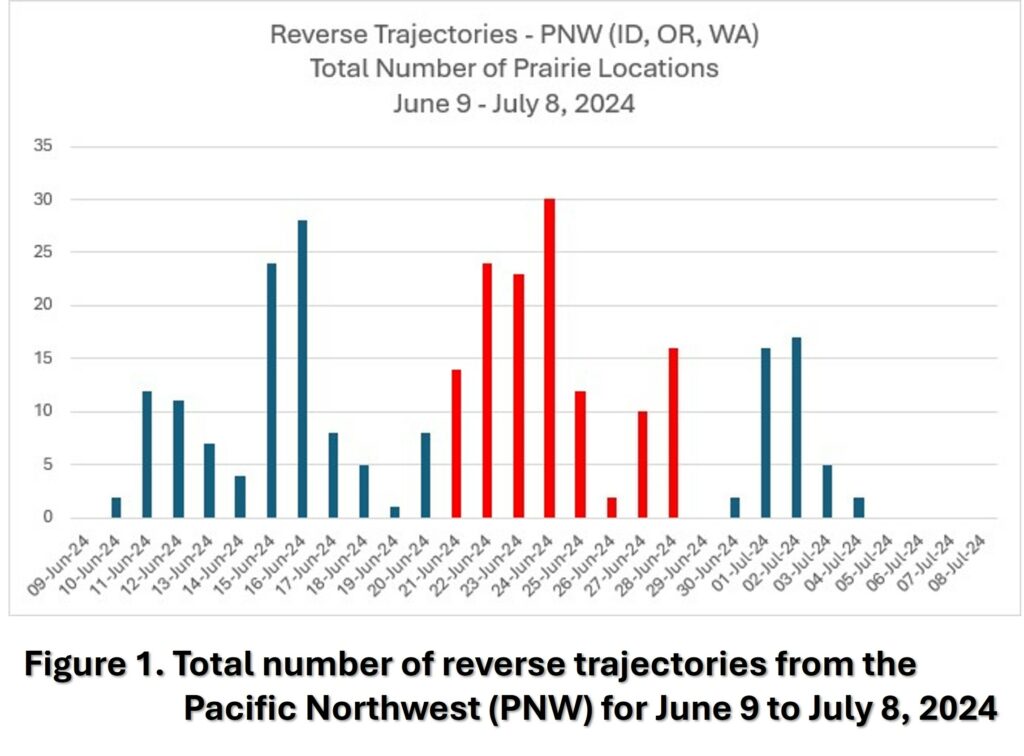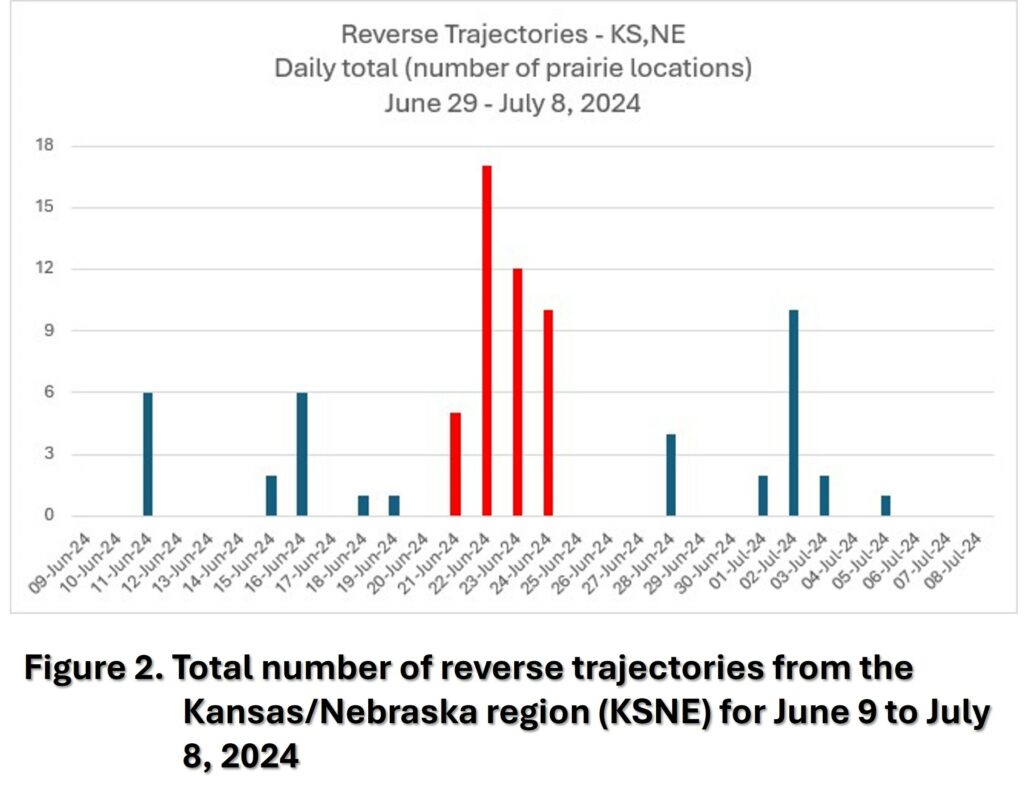Stripe rust alert for Alberta wheat producers
July 10, 2024
The Prairie Crop Disease Monitoring Network was contacted July 9, 2024, by Scott Knutt, SJK Agronomy, Lethbridge, AB regarding stripe rust observations he made yesterday in a winter wheat field in Warner County in southern Alberta. He observed that stripe rust levels were low to moderate depending on the area of the field visited. Scott indicated that the east side of the field is more affected than the west side of the field. On the east side about one of every five stems had leaves with stripe rust lesions that were distributed throughout the canopy, while on the west side of the field one of every 30 stems had leaves with lesions and mostly on the flag leaves. Stripe rust was also observed on another field of the same variety with flag leaf symptoms on one of every 50 stems. See pictures below.
Interestingly the variety for both fields was AC Wildfire that has a moderately resistant rating (MR) for stripe rust. Scott also mentioned that no stripe rust symptoms were observed on two other fields, one planted to AAC Elie (CWRS and MR for stripe rust) and the other to AAC Grainland (durum and R for stripe rust). AAFC cereal rust pathologist, Dr. Reem Aboukhaddour indicates that virulence shifts can occur, whereby the stripe rust pathogen population adapts to sources of resistance resulting in more intermediate to susceptible reactions. An example of this occurred previously with AC Radiant winter wheat, which had a moderately resistant (good) reaction in 2010, but was rated as intermediate (fair) in the 2011 variety guide, and now is listed as being susceptible in the 2024 guide.
Scott also mentioned that his colleague, Joey Slawson, SJK Agronomy, found stripe rust pustules on AAC Elie wheat in Vulcan county on July 8, 2024, although at lower levels (see pictures below). Also on Monday, Dr. Richard Cuthbert from AAFC Swift Current, noted “multiple stripe rust infections” from wheat nurseries at Swift Current (A sincere thank you to Dr. Reem Aboukhaddour for bringing this to my attention).
Previous PCDMN rust risk reports outlined the frequency of wind trajectories from the Pacific Northwest (PNW) of the USA, a source of stripe rust. From June 25 to July 1, 2024, Lethbridge had five trajectories, while Lacombe and Vulcan, AB each had four trajectories. During this same period Beiseker and Medicine Hat, AB each had three wind trajectories that could have carried stripe rust spores into these areas of Alberta.
A late June PCDMN rust risk report indicated that from June 18-24, 2024, Lethbridge had five trajectories from the PNW, while Olds had four trajectories, and three trajectories occurred for Beiseker, Calgary, Edmonton, Lacombe, Medicine Hat and Vulcan, AB. Finally a mid-June PCDMN rust risk report indicated that from June 11-17, 2024, Lethbridge and Vulcan had five trajectories from the PNW, while Beiseker and Calgary had four, and Lacombe, Medicine Hat Olds and Provost, AB had three. Thus, over the period from June 11-July 1, 2024, these locations, especially Lethbridge, had an increased number of trajectories that could have carried stripe rust spore from the PNW. Growers in these regions Alberta are encouraged to actively scout wheat fields for stripe rust symptoms as timely fungicide applications may be needed. Yield impacts are typically higher when stripe rust arrives before head emergence, although yield losses can still be problematic after head emergence, especially with more susceptible varieties. Note shifts in stripe rust pathogen virulence may also mean more resistant varieties could be impacted. Consult previous 2024 PCDMN cereal rust risk reports and in-season updates for further details.
If we look a bit more closely regarding the trajectories, since April 1, there have been 51 PNW reverse trajectories (RT’s) that have been reported for Lethbridge; there were 18 RT’s for the period of June 10- July 3 (Figure 1). If we take a closer look at results, the ECCC wind dispersal model indicates there was an increase in RT for the period of June 21-28, 2024. In general, reverse trajectories from the Kansas to Nebraska (KSNE) corridor rarely cross into Alberta. This growing season the ECCC wind dispersal model predicted that KSNE RT’s entered AB during April 7-8, May 7-0 and June 22 (Figure 2). KSNE RT’s passed over the following AB locations on June 22: Beiseker, Calgary, Lethbridge, Medicine Hat and Vulcan. Since April 1, the only KSNE RT to cross Lethbridge was on June 22. Overall, the RT data suggests that air currents, from the PNW and KSNE moved over southern AB during the period of June 21-25 and thus potentially brought in stripe rust spores. This combined with rainfall during the later part of June likely promoted spore deposition and subsequent crop infection and the appearance of symptoms and pathogen sporulation that we are now seeing. The PCDMN wishes to thank Ross Weiss, Saskatoon (retired AAFC) for his valuable analysis and insights into the wind trajectory data and weather, especially in relation to the observations regarding stripe rust appearance reports on the Prairies for this update and updates in previous 2024 PCDMN rust risk reports.


Given the recent appearance of stripe rust in commercial fields in south central Manitoba and south-central Saskatchewan and southern Alberta from late June to early July, local sources of stripe rust spores may become more important. Thus, wheat producers in these regions are encouraged to be on the look out for stripe rust in their fields.
Once stripe rust appears in a Prairie wheat crop, further development is favoured by moist humid conditions and cool to moderate temperatures. Based on information from Dr. X. Chen, WSU, Pullman, Washington, fungicide application for stripe rust is recommended from the herbicide timing stage through to flowering when the % of plants infected or the area of leaf infection approaches 5%. Staying on top of an emerging stripe rust problem in your Prairie winter or spring wheat crop is critical as yield losses are greatly increased when the disease becomes established, especially before head emergence. NOTE: pay close attention to labels for fungicides especially post-head emergence options in relation to timing, pre-harvest intervals and maximum residue limits. Consult your provincial guides to crop protection for more information (AB Guide, SK Guide, MB Guide).
The PCDMN wishes to sincerely thank Scott Knutt and Joey Slawson for their willingness to share their observations and pictures regarding the appearance of stripe rust in southern Alberta. Their collaboration is key to having a successful Prairie-wide network regarding field crop diseases.





